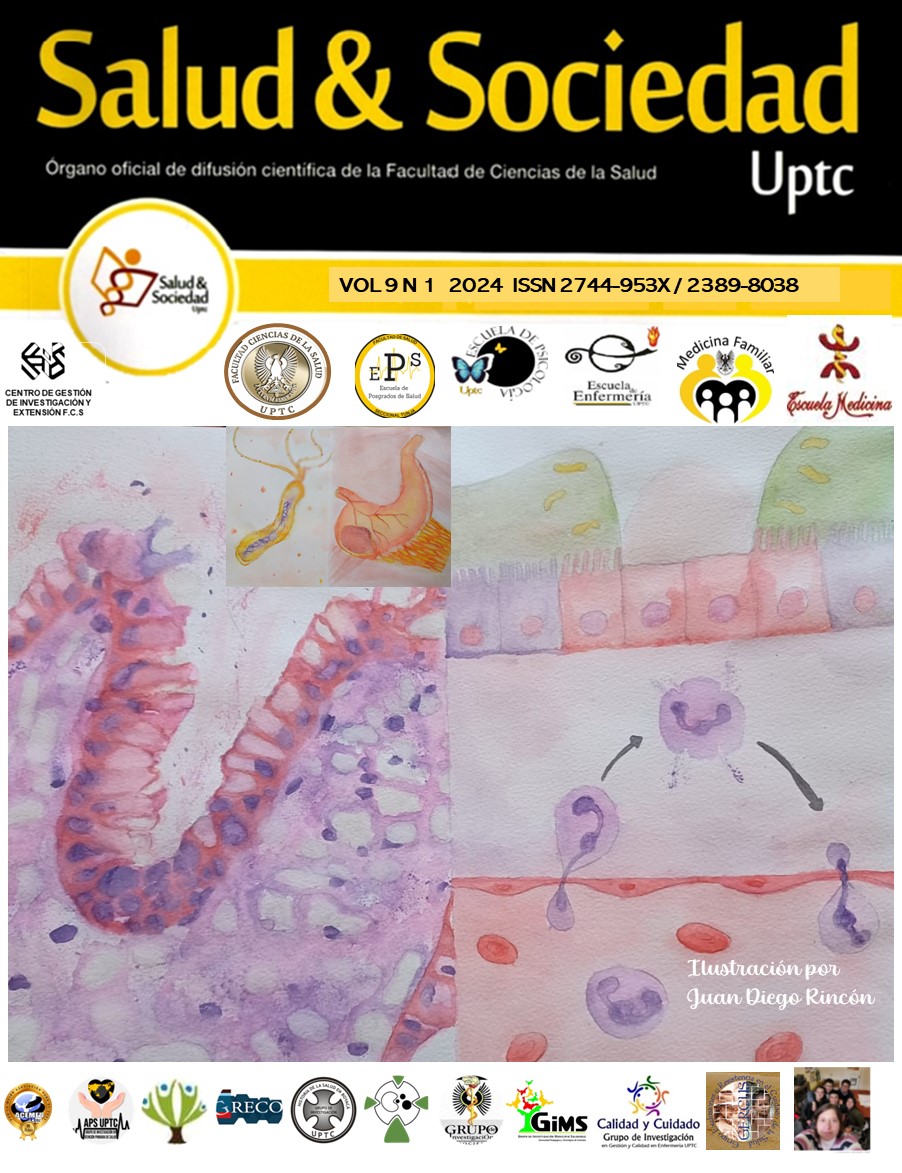Prevalencia de nomofobia en estudiantes de medicina de la UPTC 2023

Resumen
Introducción: en los últimos años, el uso masivo e inadecuado de los teléfonos móviles está ocasionado un aumento considerable en el número de problemas mentales relacionados a la tecnología. Objetivo: estimar la prevalencia de nomofobia por medio del cuestionario de Nomofobia (NMP-Q) (2015), en estudiantes de medicina del área clínica de la UPTC. Metodología: estudio observacional, descriptivo de corte transversal. Población: sujetos entre 18 y 26 años de edad que estudian medicina en la Universidad Pedagógica y Tecnológica de Colombia; muestra no probabilística, secuencial por conveniencia. Se utilizó la versión adaptada al español de la Escala de Nomofobia (NMP-Q), compuesta por 20 ítems. Resultados: prevalencia significativamente mayor de nomofobia con niveles de leve 20,0%; Nomofobia moderada 70,0% y nomofobia severa 10,0%. Se encuentra una mayor prevalencia de nomofobia severa en el sexo femenino. Conclusiones: Estos hallazgos revelan una problemática que afecta a la totalidad (100%) de la población estudiantil de este estudio, compuesta por jóvenes adultos. Al contrastar estos resultados con investigaciones previas, se destaca una prevalencia significativamente mayor de nomofobia en comparación con estudios que informan que el 70.76% de la población adulta en general se ve afectada por esta fobia. Es pertinente señalar que esto podría tener un impacto sustancial en diversas funciones cognitivas, en los hábitos de estudio e incluso en la salud mental de los estudiantes. Se sugiere continuar con investigaciones adicionales relacionadas con esta temática, ampliando la muestra de estudiantes, y buscando la implementación de estrategias diseñadas para abordar eficazmente esta fobia característica de la era moderna.
Palabras clave
Estudiantes de Medicina, Adicción a la tecnología, Salud Mental
Biografía del autor/a
Lina Margarita Charry Jiménez
Médica Interna, FOSCAL
María Paula Rodríguez Duque
Médica Interna, HRD
Ludy Stefany Oviedo Delgado
Médica Interna, FOSCAL
Ledmar Jovanny Vargas Rodríguez
Médico epidemiologo. Hospital Regional de la Orinoquía
Citas
- Liu JCJ, Ellis DA. Editorial: Eating in the Age of Smartphones: The Good, the Bad, and the Neutral. Front Psychol. 2021 Dec 6;12:796899. doi: 10.3389/fpsyg.2021.796899. PMID: 34938246; PMCID: PMC8685243.
- León Mejía A , et al. Una revisión sistemática sobre la prevalencia de la nomofobia: resultados a la vista y directrices estándar para futuras investigaciones. PLOS ONE.2021.https://doi.org/10.1371/journal.pone.0250509
- Antoni Aguiló P, Sánchez F, Pareja-Bezares A. Uso del Teléfono Móvil, Estilo de Vida y Bienestar Psicológico en Estudiantes Universitarios [Internet]. 2022. Disponible en:
- https://documentacion.fundacionmapfre.org/documentacion/publico/es/media/group/1117134.do
- Humood A, Altooq N, Altamimi A, Almoosawi H, Alzafiri M, Bragazzi NL, Jahrami H. The Prevalence of Nomophobia by Population and by Research Tool: A Systematic Review, Meta-Analysis, and Meta-Regression. Psych. 2021;3(2):249–258. doi: 10.3390/psych3020019
- Martínez-Hernández N, de-León-Ramírez L, Profet-Naranjo A. Nivel de nomofobia en universitarios cubanos. Progaleno [revista en Internet]. 2023 [citado 23 Sep 2023]; 6 (1) :[aprox. 8 p.]. Disponible en: https://revprogaleno.sld.cu/index.php/progaleno/article/view/407
- Almeida O, Moreno J, Hapuc K, Duarte E, Silva CA. Identificación de la relación existente entre los factores predisponentes y mantenedores en la presencia de nomofobia en los estudiantes de Psicología vinculados a la Corporación Universitaria Minuto de Dios, Bucaramanga. Revista Boletín, REDIPE. 2018;7(10):216-234.
- Disponible en: https://revista.redipe.org/index.php/1/article/view/593/564
- González-Cabrera J, León-Mejía A, Calvete E, Pérez-Sancho C. Adaptación al español del Cuestionario Nomophobia Questionnaire (NMP-Q) en una Muestra de Adolescentes. Actas Españolas de Psiquiatría. 2017;45(4):137–144. pmd:28745386
- Yildirim C. Exploración de las dimensiones de la nomofobia: desarrollo y validación de un cuestionario utilizando métodos de investigación mixtos. Universidad del Estado de Iowa; 2014.
- Augner C, Hacker GW. Association between problematic mobile phone use and psychological parameters in young adults. Int J Public Health. 2012; 57(2): 437-41.
- Daraj LR, AlGhareeb M, Almutawa YM, Trabelsi K, Jahrami H. Revisión sistemática y metanálisis de los coeficientes de correlación entre nomofobia y ansiedad, adicción a los teléfonos inteligentes y síntomas de insomnio. Salud 2023;11:2066. https://doi.org/10.3390/healthcare11142066.
- Fulkerson J.A., A Loth K., Bruening M., Berge J.M., Eisenberg M.E., Neumark-Sztainer D. Time 2 tlk 2nite: Use of electronic media by adolescents during family meals and associations with demographic characteristics, family characteristics, and foods served. J. Acad. Nutr. Diet. 2013;114:1053–1058. doi:
- 1016/j.jand.2013.10.015.
- Schwaiger, E. y Tahir, R. (2022). El impacto de la nomofobia y la presencia de teléfonos inteligentes en la inteligencia y la atención fluidas. Ciberpsicología: Revista de investigación psicosocial sobre el ciberespacio , 16 (1), artículo 5. https://doi.org/10.5817/CP2022-1-5
- Smetaniuk P. A preliminary investigation into the prevalence and prediction of problematic cell phone use. J Behav Addict. 2014; 3(1): 41-53.
- Oto E, Barrero L, Arezes A, Barrena N, Barrena S, Bonilla A. Nomofobia, articulo monográfico. Revista sanitaria de investigación, 2022. Disponible [en línea]: https://revistasanitariadeinvestigacion.com/nomofobia-articulo-monografico/
- León Mejía A. Nomofobia: Revisión de la literatura y desarrollo de la versión española del Nomophobia Questionnaire (NMP-Q). Universidad de Salamanca. Septiembre, 2021. Disponible [en línea]:
- https://gredos.usal.es/bitstream/handle/10366/149382/Le%C3%B3nMej%C3%ADaAC.pdf?sequence=1&isAllowed=y
